IntelliLux™ DayLight Sensor (DLS) Technology
- Overview
- How it Works
- Advantages
- Intellectual Property Protection
- Summary of Key Points
Overview
The IntelliLux™ DayLight Sensor (DLS) senses the daylight level in a room while ignoring the illumination produced by high-efficiency lighting systems, such as those using fluorescent or LED lamps.
While the IntelliLux™ DLS has many applications, it was developed specifically for use as a reference sensor for closed-loop Dynamic Daylight Control (DDC) for non-residential daylighting applications. The following chart shows a functional block diagram of a closed-loop DDC system:
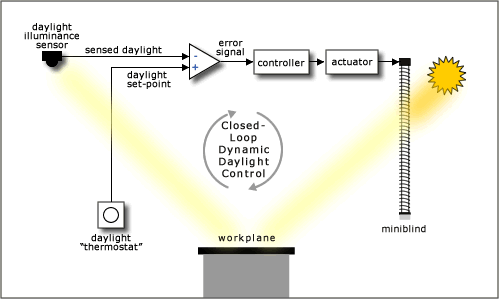
The controller adjusts the shading device to minimize the difference between the desired daylight level and the actual daylight level in the room, as measured by the daylight sensor. This type of closed-loop control can provide excellent regulation of the admitted daylight.
However, there's a catch: in daylighting applications, DDC systems are used in conjunction with daylight-harvesting lighting controls, which automatically dim the lamps in order to take advantage of available daylight. If the daylight sensor is sensitive to the light produced by the lamps—as conventional daylight sensors are—then the system will confuse changes in the dimming level with changes in the daylight level.
There are two conventional work-arounds: (1) subtract the estimated lighting contribution from the sensor output, or (2) position and shield the sensor do it doesn't "see" any artificial illumination.
The IntelliLux™ DLS provides a much more cost-effective and elegant solution to this problem.
How it Works
Daylight contains wavelengths of light that aren't visible to the human eye—near-infrared and near-ultraviolet wavelengths, for example.
Incandescent lamps also radiate quite a bit of power in infrared wavelengths. But, because power radiated at non-visible wavelengths represents wasted electricity, incandescent lamps are virtually never used for area lighting in today's non-residential buildings.
Instead, non-residential area lighting is currently almost exclusively of the fluorescent type. Fluorescent lamps are far more efficient than incandescent lamps, because they radiate very little power at non-visible wavelengths. Similarly, high-efficiency LED-based lamps, which are expected to eventually replace fluorescent lamps for non-residential area lighting, also radiate very little power at non-visible wavelengths.
The IntellLux™ DLS takes advantage of the relatively narrow spectrum of high-efficiency artificial illumination by using a near-IR photosensor to sense only those wavelengths that are just slightly lower than the visible range. The following chart shows the spectral response of a near-IR photodiode used in an IntelliLux™ DLS prototype, compared to typical daylight and fluorescent lamp spectra:

As shown in Chart 2, the IR photodiode response overlaps the daylight spectrum, but falls outside the spectrum of fluorescent illumination (as well as the spectrum of LED area-lighting systems, which isn't shown on Chart 2).
Further, unlike the far-IR wavelengths sensed by a Passive IR (PIR) occupancy sensor, the near-IR wavelengths sensed by the photodiode are close enough to the visible spectrum that they're affected by weather—and reflections by natural and man-made objects—in much the same way as visible daylight. Even better, the differences between near-IR and visible light are such that the IntellLux™ DLS is much more sensitive to glare than conventional sensors.
As a result, the output of the IntelliLux™ DLS tracks the subjective daylight level accurately enough for excellent glare-blocking DDC operation, but ignores the illumination produced by future high-efficiency artificial lighting systems.
Advantages
While DDC is the key to effective daylighting in buildings with ordinary eye-level windows, conventional DDC technology is far too complex and expensive for mainstream commercial use. IntelliLux™ DLS radically simplifies DDC, and is a key contributor to unprecedented cost-effectiveness of the IntelliBlinds™ Model D miniblind actuator in daylighting applications.
Simple, Inexpensive Design
If the vertical axis of Chart 2 had used a logarithmic scale spanning two orders of magnitude—instead of a linear scale—then there would, indeed, be a slight overlap between the fluorescent spectrum and photodiode response. That's because fluorescent lamps do produce very low levels of IR. This can be an issue for IR remote control systems, because IR signals are relatively faint when they reach their receiver.
However, the IR component of daylight sensed by the IntelliLux™ DLS is far stronger than the low-level pulsed signals used for IR remote control. Further, unlike IR remote control signals (and unshaded daylight), the daylight sensed by the IntelliLux™ DLS has only a relatively small dynamic range because it has already passed through the DDC system's shading device.
These factors make the IntelliLux™ DLS extremely easy to implement. In fact, while the optimum electronic configuration will depend on the specifics of the application, excellent performance can be obtained with an IntelliLux™ DLS design consisting of just a couple of inexpensive components:
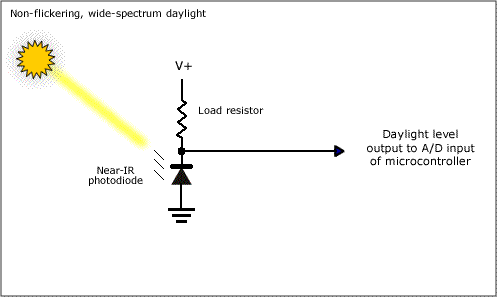
These components add less than $1.00 to the retail price of the system—less than five percent of the cost of the portions of a conventional DDC system they replace.
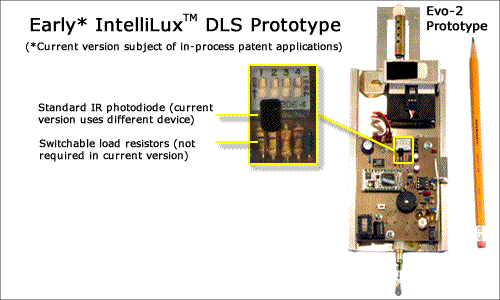
Can Be Integrated Into Shading Device
One of the major advantages of the IntelliLux™ DLS is that, because it's sensitive only to daylight, it doesn't have to be shielded (or pointed away) from the room lights. That's a major advantage for use with DDC systems based on motorized blinds or shades, because it means that the IntelliLux™ DLS can be co-located with the rest of the electronics at the top of the window. And that, in turn, enables a fully self contained system—significantly reducing system cost and complexity.
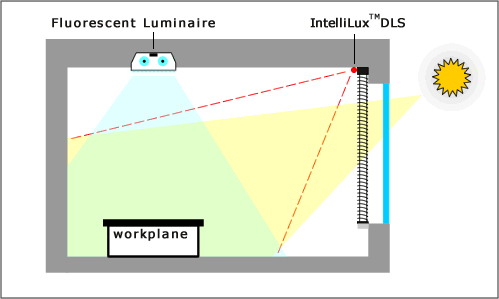
Effectively Senses Glare
For maximum cost-effectiveness in daylight-harvesting applications, a DDC system must admit as much daylight as possible without risk of glare. So, sensing glare is far more important for DDC than measuring the daylight in terms of conventional photometric quantities. And the IntelliLux™ DLS does a much better job of sensing glare than conventional sensors.
Highly Sensitive to Sunlight
Sunlight (as opposed to diffuse daylight) is the dominant cause of glare in daylit spaces. Because of its spectral response, the IntelliLux™ DLS is an order of magnitude more sensitive to sunlight than to diffuse daylight.
That—coupled with the fact that the illuminance of direct or reflected sunlight is typically far greater than that of diffuse daylight—means that the output of the IntelliLux™ DLS will spike if there's even a small patch of sunlight anywhere in its field of view.
Can See Entire Room
In addition to reducing cost, the ability of the IntelliLux™ DLS to be mounted at the top of the window gives it another advantage: it can "look" inward and downward along the same path that daylight follows into the room. That perspective enables it to see every part of the room that might receive glare-inducing sunlight. In contrast, conventional illumination sensors are typically ceiling-mounted and look straight down, seeing only a fraction of the daylit area.
Capable of Detecting Direct Sunlight Anywhere in the Sidelit Zone
Its high sensitivity to sunlight, coupled with its whole-room field-of-view, enable the IntelliLux™ DLS to detect incipient glare anywhere in a sidelit zone.
For example, the following charts plot the actual outputs of the IntelliLux™ DLS and two conventional sensors under varying levels of daylight glare (but with no artificial illumination). The sensors were positioned in the same sidelit space in the metro-DC area, with a west-facing window shaded by a Venetian blind.
Each chart shows four curves, with each curve representing the sensor output versus slat tilt angle at a particular time.
The four curves span a half-hour interval in the late afternoon on a cloudless December day. During this half-hour interval, the solar disc emerged from behind a nearby building and began to directly illuminate the window:
- When the interval began, at 15:44, there was no direct sun on the window and no glare anywhere in the room, regardless slat tilt angle.
- Just 15 minutes later, at 15:59, direct sun began to illuminate the the window and reached a portion of the interior window frame at certain slat tilt angles.
- At 16:08, up to 30% of an interior side wall was receiving direct sunlight over the slat-tilt range, causing about 20% of the floor area to be subjected to severe glare at eye level.
- Finally, at 16:14, up to 60% of the same interior side wall was receiving direct sunlight over the slat-tilt range, causing about 40% of the floor area to be subjected to severe glare at eye level.
The first chart is for a conventional WorkPlane Illuminance (WPI) sensor, which was mounted at desk height* 0.8 window head-heights inward from the window:

Chart 6 illustrates why conventional WPI sensors are useless for closed loop glare control: despite the fact that up to 40% of the floor area is subject to severe glare at 16:14, the WPI never exceeds an ergonomically correct 475 lux. In fact, the 15:59 curve is almost exactly the same as the 15:44 curve, despite the fact that direct sun has begun to penetrate the room.
The next chart is also for a conventional illumination sensor (with photopic spectral response)—but this time co-located with the IntelliLux™ DLS at the top of the window, and with the same aim point and field of view as the IntelliLux™ DLS:

Comparing Chart 7 with Chart 6 shows that a conventional illumination sensor that "sees" the same scene as the IntelliLux™ DLS can do a slightly better job of detecting glare than a conventional WPI sensor: its peak output at 16:14 is 3.5 times greater than the peak output at 15:44 (Chart 7), versus a factor of just 2.0 for the conventional WPI sensor (Chart 6).
However, while the sensitivity to room-wide glare is greater than that of a WPI sensor, it's still not sensitive enough to detect glare in the corners of the room: the peak output at 15:59 is just 20% greater than the output at 15:44.
Finally, the next chart is for the IntelliLux™ DLS mounted at the top of the window:

Note that the peak output of the IntelliLux™ DLS increases by more than 100% from 15:44 to 15:59 (versus an increase of just 10% for the WPI sensor of Chart 6), despite the fact that only a portion of the interior window frame is receiving direct sunlight.
And by 16:14, when substantial direct sunlight is penetrating the daylit zone, the peak output has grown to about is about 20 times the peak at 15:44 (versus a factor of just 2 for the WPI sensor of Chart 6).
Combining the data of Charts 6 and 8, the following chart shows the ratio of the IntelliLux™ DLS output to that of the conventional WPI sensor as a function of slat tilt angle:

So, when there is no direct sun on the window, the response of the IntelliLux™ DLS is very similar to that of the conventional WPI sensor. However, as the floor area subject to glare increases, so does the relative sensitivity of the DLS, rising to 700% when the slats are fully open at 16:14.
Thus, if there's direct sunlight anywhere in a sidelit area, the IntelliLux™ DLS will sense it—and that's something that conventional sensors just can't do.
Enables Use of Blinds' Full Tilt Range
One of the advantages of Venetian blinds in DDC applications is that they provide angular selectivity of the admitted daylight, with the direction of maximum admittance determined by the slat tilt. For example, tilting the slats to allow a view of the sky maximizes the daylight admittance, but also increases the risk of glare from bright clouds or direct sunlight. Conversely, tilting the slats to allow a ground view reduces the admitted daylight, but also reduces the risk of glare.
Because avoiding glare is more important than maximizing daylight—and because conventional illuminance sensors aren't very good at sensing glare—blind-based DDC systems typically restrict the slat-tilt range to prevent a direct view of the sky.
But with the IntelliLux™ DLS, no such restrictions are necessary. Because it can sense glare anywhere in the room, the full slat-tilt range can be used without risk of glare. And that, in turn, increases the savings achievable with daylight harvesting by about one-third.
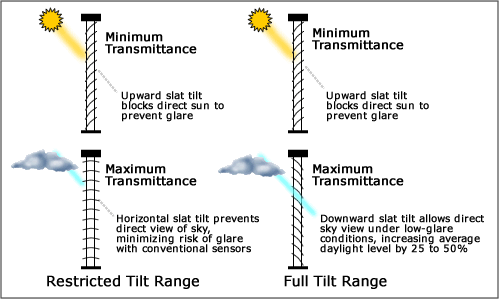
Requires No Site-Specific Calibration or Tuning
Some sensors must be calibrated for absolute accuracy. For example, because it can take significant time for an HVAC system to change the temperature in a room, a temperature sensor in an HVAC thermostat must be calibrated for absolute accuracy in degrees; otherwise, a user wouldn't know what temperature the room would eventually reach after a thermostat adjustment.
On the other hand, a daylight sensor used in a DDC system like the IntelliBlinds™ Model D doesn't necessarily need to be calibrated for absolute accuracy, for three reasons:
- In contrast to the HVAC scenario, users can immediately see the effect of a change in the set-point of a blind-based DDC system. For example, with IntelliBlinds™, a user simply twists the IntelliTwist™ Wand until the desired daylight level is reached, and the system automatically maintains that level thereafter. Thus, as far as the user is concerned, the photometric daylight level (e.g. in lux on the workplane) is irrelevant.
- For a DDC system, avoiding glare is even more important than maximizing useful daylight. But glare is a subjective phenomenon that's poorly correlated with conventional photometric quantities, so absolute accuracy isn't necessarily advantageous for glare-blocking operation.
- When there isn't any glare, people can comfortably tolerate a wide range of daylight illuminance and luminance—so absolute accuracy isn't advantageous under low-glare conditions, either.
However, a daylight sensor used for DDC does need relative accuracy: its output must track the daylight level as perceived by the room occupants. And conventional daylight sensors can't provide adequate relative accuracy without labor-intensive, site-specific tuning.
That's because conventional daylight sensors can't discriminate between artificial and natural illumination, and therefore can't directly track the daylight component of the ambient illumination. DDC systems using conventional sensors attempt to get around this problem by estimating the relative daylight component of the total illumination, using one of two techniques:
- Conventional open-loop systems estimate the interior daylight level as a function of the exterior daylight level and the setting of the shading device.
- Conventional closed-loop systems estimate the interior daylight level by subtracting the estimated artificial component (based on the dimming level of the lamps) from the total illumination.
In addition to increasing system cost and complexity, both of these approaches require site-specific tuning over the full range of shading settings and lighting levels in order to achieve full performance. And even then, the estimated daylight level is often poorly correlated with the perceived daylight level (particularly in the context of glare).
In contrast, the IntelliLux™ DLS directly senses a daylight component of the interior illumination, so there's no need for a daylight-estimation algorithm. And the near-IR daylight component it senses is highly correlated with glare, so the IntelliLux™ DLS provides superior DDC performance out-of-the-box—with no need for site-specific calibration or tuning whatsoever.
Eliminates Need for Sun-Position and Slat-Tilt Information
As previously noted, a DDC system must avoid glare or excessive solar heating at all costs. The greatest glare results from sunlight (versus diffuse daylight), so the way in which a DDC system responds to direct sun is an important determinant of its effectiveness.
One way to handle direct sun is to simply fully close the shading—but that also blocks useful daylight. The most sophisticated DDC systems are capable of selectively blocking direct sun while still admitting useful natural illumination. This can be done using horizontal blinds or roller shades:
- A roller shade can be extended or retracted, as a function of the solar elevation angle, to control the depth of penetration of direct sun within a room.
- The tilt angle of the slats of a horizontal blind can be adjusted, again as a function of the solar elevation angle, to prevent direct sun from entering the room at all—while still admitting diffuse daylight.
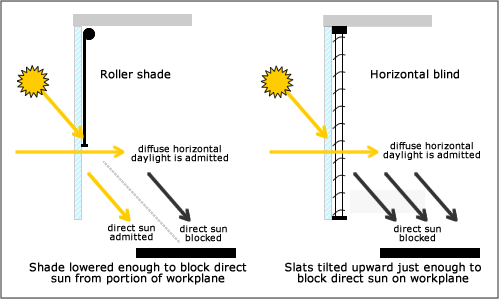
Using a horizontal blind to block direct sun in the way depicted in Chart 11 provides the greatest savings possible with DDC. However, with conventional technology, the DDC system needs two pieces of information to do this:
- The absolute tilt angle of the blind's slats, in degrees. This can be measured directly (for example, using a MEMS accelerometer affixed to a slat or to the blind's internal tilt rod). Alternatively, it can be estimated as a function of the motor displacement, but that requires a high-quality blind and careful tilt-angle calibration. Either way, costs go up.
- The solar elevation angle. This can be calculated by a computer as a function of the window orientation, the time of day, the day of the year, and the local lattitude and longitude. Alternatively, it can be measured directly with a solar Angle of Incidence (AoI) sensor. The solar position information can be obtained separately for each window in a daylit building, or it can be shared across the building by networking the DDC systems together. But regardless of how it's done, the result is a substantial increase in system cost and complexity.
This information is enough to enable a DDC system to tilt the slats just enough to block direct sunlight. However, because of potential inaccuracies in the slat tilt angle and solar elevation, the slats must be tilted a little further than that, reducing useful daylight.
The IntelliLux™ DLS doesn't just eliminate the complexity of conventional sun-blocking operation—it also provides better performance:
- If there's even a small patch of direct sunlight anywhere in the room, the output of the IntelliLux™ DLS will spike upward.
- In a closed-loop DDC system like IntelliBlinds™, this will then cause the slats to be tilted (or the shade to be lowered) to return the DLS output to its nominal value—automatically providing only the minimum shading necessary to eliminate the sunlight patch.
- And this doesn't just block sunlight directly from the solar disc; it also blocks sunlight reflected from nearby glass facades. And that's something that conventional sun-blocking systems just can't do.
Eliminates Need for External Daylight Sensor
All conventional DDC systems need to "know" whether it's daytime or nighttime. Some systems use an external daylight sensor (e.g. a shielded photoresistor mounted at the window) for this purpose, while others infer the day/night state using a real-time clock/calendar and the calculated dusk/dawn times for the prevailing geographical coordinates.
Depending on the type of shading device in use, the IntelliLux™ DLS can eliminate the need for such measures. Horizontal blinds (as well as most other types of window covering) aren't completely opaque even when they're fully closed, so there is always some daylight in the room—regardless of the shading setting—as long as the sun hasn't set. This means that the IntelliLux™ DLS output inherently contains "dusk/dawn" information, potentially eliminating the need for additional sensors or a real-time clock/calendar.
Intellectual Property Protection
IntelliLux™ DLS sensor technology is protected by U.S. utility patent 6,084,231, with additional patents applied for.
Summary of Key Points
- The IntelliLux™ DayLight Sensor (DLS) senses daylight while ignoring the illumination produced by high-efficiency lighting systems, such as those using fluorescent or LED lamps
- Works by taking advantage of the fact that daylight contains substantial power near-IR wavelengths, while the light produced by high-efficiency artificial lamps doesn't
- Developed primarily for Dynamic Daylight Control (DDC) in non-residential daylighting applications
- Far less expensive than conventional illuminance sensors
- Can be integrated with the rest of the electronics of a headrail-mounted automated shading system, eliminating the need for remote sensors or wiring
- Highly sensitive to direct sunlight, enabling closed-loop glare control:
- Enables automatic blocking of reflected as well as direct sunlight
- Eliminates the need for sun-position and slat-tilt information
- Allows use of Venetian blinds' full tilt range without risk of glare
- Requires no on-site calibration
- Sensitive enough to detect the "leakage" of daylight past a fully closed blind, potentially eliminating the need for a conventional external daylight sensor

